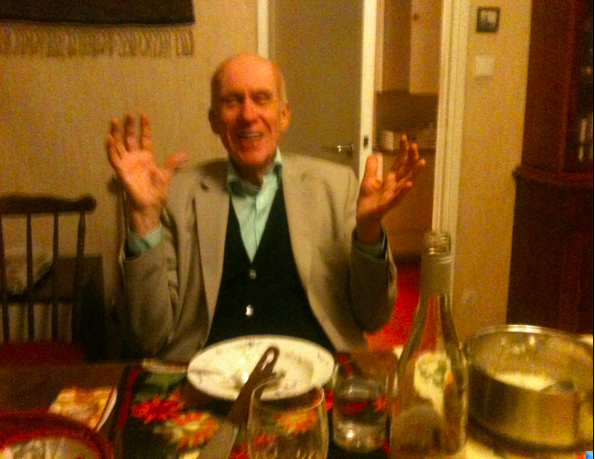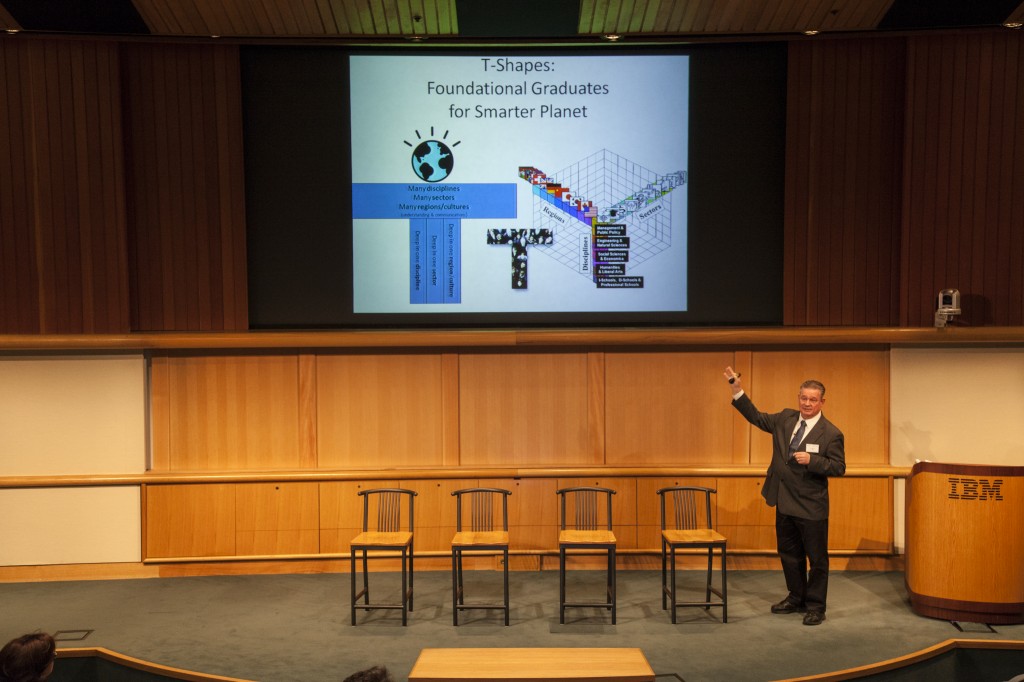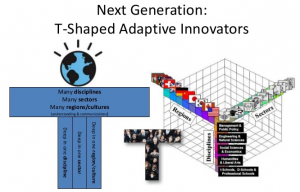On my last visit to Sweden in early 2013, I gave a talk on service science in the city of Karlstadt at the Sweden-US Bridge Conference, and then visited one of my mentors Prof. Evert Gummesson at his home in a wonderful neighborhood outside Stockholm. It was a fun evening of sharing stories on so many every day topics, including fish stories of “the ones that got away.”

The one that got away
Evert Gummesson is one of the “founding father’s” of modern service thinking, including a major influence on service science (Spohrer & Maglio) and service-dominant logic (Vargo & Lusch) through his work on relationship marketing, many-to-many-networking, qualitative methods, the Nordic School of Service Research (so many great service thinkers from such a small region!), and co-founding the Naples Forum on Service. In fact, I was surprised and honored by Prof. Gummesson earlier this year at the “Naples Forum on Service” with the “Gummesson Outstanding Researcher” award, for my decade-long efforts to link service researchers and computer scientists better via the service science work of myself and many colleagues (IBM’s SSME initiative). I also surprised and honored to receive] the “Service-Dominant Logic” award at that same conference, for efforts to explore the possibility of a “Moore’s Law for Service Systems Scaling.” On the topic of service-dominant logic which provides the foundational logic and worldview for service science, Vargo and Lusch have a new book out from Cambridge University Press, and my Foreword to the book is a short summary of my impressions while reading their latest framing of service-dominant logic to introduce it to new comers as well as those who have been following the journey from its beginning over a decade ago.
What becomes very clear when visiting Sweden is that Sweden embraces service innovation as a national priority. Organizations like Teknikföretagen and Almega are leaders in advancing the innovation thinking of many companies and their employees in Sweden (some quotes below):
“Teknikföretagen has more than 3,500 companies under its wing.
Teknikföretagen contributes to strengthening the competitiveness of our members by influencing current and future events. With our help, our members can develop new ideas to enable the Swedish economy to grow in a sustainable fashion and make the world a slightly better place.
In a globalised world, creativity is Sweden’s strength.”
“Almega –employer and trade organisation for the Swedish service sector
Sweden today is very much a service-orientated society. Nearly 75 percent of the economically active population works with the provision of services, either in private companies or the public sector. The private service sector has created the majority of new jobs since the mid-1990s.
Almega is an organisation that supports service companies in Sweden. The association has 10,000 member companies employing some 500,000 people. We spearhead development for our member companies in all matters regarding employer-staff relations, and in public policy issues.”
In on-going discussions with old and new colleagues in Sweden, I plan to explore:
– The deep (and non-obvious to most) relationship between service science and IBM’s Smarter Planet initiative (this is fundamental and important)
– The deep (and non-obvious to most) relationship between service innovation excellence and IBM’s T-shaped Talent initiative (21st Century Talent – 21C Talent)
– The deep relationship between universities, metro regions, and entrepreneurship (For example, the Videum Science Park, at Linneaus Unieristy in Vaxjo)
– There is a desire to have an ISSIP Ambassador for Teknikföretagen and Almega.
The gist on the above is creating and sustaining the future workforce with an understanding of regional and global innovation opportunities. From both service science (service systems) and ervice-dominant logic (resource integrators) perspectives, smart service systems/resource integrators benefit from both provider and customer capabilities (Sweden’s IKEA certainly pioneered this concept, and also see NSF LinkedIn Group on Smart Service Systems) and perhaps these capabilities can someday be put on a Moore’s Law-like continuous improvement trajectory, increasing quality, productivity, compliance, innovativeness, sustainability, resilience, and equity (competitive parity). The focus of professional development, research, education, practice, policymaking quickly shifts to quality-of-life improvements across all sectors of business and society (transportation, water, agriculture&manufacturing, energy, communications, buildings, retail&hospitality, finance, healthcare, education and government). The focus also shifts to local and global innovation platforms (IBM and other companies Smarter System of Systems work), platforms can scale the benefits of local innovation globally, rapidly, and sustainably – both technological platforms (e.g., smart phones, smarter city intelligent-operation-centers, Watson-in-the-Cloud, etc.) and organizational platforms (e.g., franchises, etc.). For example of a Swedish “organizatioal platform,” I am very impressed that whereever I go in the world, I see the impact of Swedish entrepreneurs and investors, working with local universities and encouraging startups.
Exploring all of these topics is an umbrella professional network known as ISSIP (pronounced I-ZIP, as in innovation zips around the world, faster and faster):
ISSIP Mission: Promoting service innovations for our interconnected world.
ISSIP Objectives: Global professional network of T-shaped service innovators, including students, educators, researchers, practitioners, and policymakers.
ISSIP Service Definition: The application of knowledge for mutual benefits (processes that co-create value and co-elevate capaibilities).
ISSIP Service Innovation Definition: Scaling of benefits of new knowledge globally, rapidly, and sustainably.
Registering to become a member of ISSIP is fast and easy.
Service science is a relatively new initiative (just a decade of weaving multiple disciplinary threads together to focus on smart service systems) and ISSIP is even newer (just over one year of building a cross disciplinary, cross sector, cross cultural global professional network of T-shapes), but one thing is sure – both these efforts have and will continue to benefit from the pioneering efforts of Sweden’s service researchers, educators, practitioners, and policymaker advisors, especially Professor Evert Gummesson and his work.


